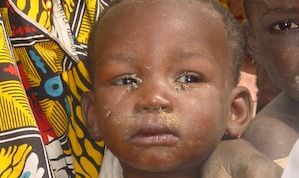Understanding the disease

Noma, deriving from the Greek “nomein” meaning “to devour”, is a virulent necrosis that develops in the mouth, starting with a benign lesion but ends up by devastating the face in an atrocious way. It rapidly destroys both the soft and bony tissues of the face and radically disfigures its victims, mostly young children between the ages of two and six. Between 80% and 90% of them die, to total indifference. The survivors will no longer be able to feed themselves, nor to speak or breathe normally. Most of the time, they will be rejected by their communities, who think they have been cursed.

Disease of Infection
Any child living on an unbalanced diet in precarious conditions can fall victim to noma.
Noma is not transmissible from person to person, nor is it associated with any virus or bacteria. It is an infection provoked by a combination of several factors:
• Lack of hygiene, especially oral hygiene,
• Malnutrition caused by food scarcity, which weakens the body,
• Lack of primary care, because the nearest clinic is too far away, and
• Effects of infectious and parasitic diseases such as measles, scarlet fever, malaria or AIDS, which weaken immune defense systems.
The situation is exacerbated by the poor living conditions that characterize extremely poor countries:
• Problems of access to clean water and health care,
• Difficulties for malnourished mothers to breastfeed, in circumstances where breast-milk is the only source of nourishment for infants in very poor families,
• The proximity of livestock to the heart of the village, and the lack of hygiene that implies,
• The ignorance of families and communities, who do not realize that noma can be cured, and believe they have been struck by a curse. The survivors are then subjected to discrimination and stigmatization by their community.
Even in countries where there is no famine, children remain malnourished. They lack protein, vitamins and iron and have difficulty resisting attacks of malaria and diarrhea, which can weaken a child very quickly.
For more information please read the following articles:
- Noma : an « infectious » disease of unknown aetiology
- Noma (cancrum oris)
Stages of development

Antibiotics costing a few dollars, administered in time, check the disease
The first signs of Noma are:
• Small, extremely painful sores inside the cheeks or on the gums which may bleed (ulceronecrotic gingivitis);
• bad breath;
• fever;
• loss of appetite.
The child needs to be treated now, to prevent the worst from happening…
At this stage, the disease could be checked with disinfecting mouth-wash, a boost to the diet with vitamins, and a course of antibiotics, provided that health centers, community health workers and traditional practitioners have the necessary knowledge.
Without treatment, the child becomes feverish, loses his appetite and natural immunity. He becomes weaker as the disease gets stronger. Noma develops within days and leads to an edema of the mouth or cheeks, which soften and develop swellings.
This is a medical emergency, and antibiotic treatment must be administered as soon as possible to save the child’s physical integrity...
Otherwise, everything happens very quickly. Dark blisters appear on the fleshy areas, which are beginning to decompose. Necrosis then destroys the flesh and bony tissues in just a few days. The child’s jaws lock in the closed position, he is no longer able to eat, and many respiratory problems arise. A gangrenous scab forms which leaves a gaping hole in the face when it falls off.
This is the end of the acute phase of the disease, at which point only surgery can repair the damage. In the absence of any treatment, the child will die in 90% of cases, often leaving no trace…
The survivors, disfigured for life, are left with sequelae that mean they can never again eat, speak or breathe normally. As with leprosy victims, they are often ostracized by their own communities.
Human consequences
A curse for their family and village
The physical, psychological and social consequences are all equally tragic:
• Damaged vital functions: As the disease progresses, the jaws become locked. Victims slowly lose the use of their mouths. It becomes increasingly difficult to eat, breathe or see as the infection attacks the nose and sometimes the eyes.
• Death rate: Seventy to 90% of those who are left untreated succumb to the infection and/or die of hunger after losing the ability to eat.
• Disfiguration for survivors: The disease causes progressive, often excruciating, disfigurement of the face, due to scar contracture. Head eaten away, jaws welded together, eyes often damaged, such is the fate of children with noma.
• Rejection by their loved ones: Struck down by a devastating evil, considered a curse by their family and village, Noma victims - like leprosy sufferers - are often rejected by their own communities and abandoned to their fate in the middle of nowhere.







